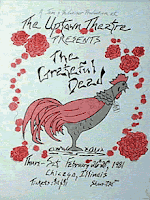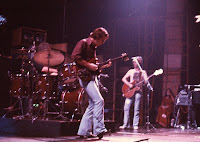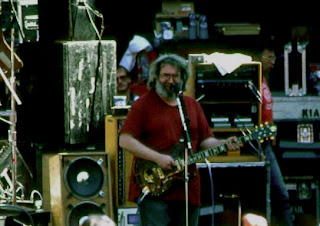
Thursday, February 26, 1981
Uptown Theater – Chicago, IL
Audience & Soundboard Recordings
Let’s go back to the Uptown Theater in Chicago. The band played a total of 17 shows at this venue from 1978 to 1981. Early on, we visited the first run from May ’78. Now we will visit the last, from February ’81. Consistent with the sentiment that there was never a bad show played at the Uptown, the Dead’s final stand at the Uptown proves the point yet again. And, while there is little trouble bumping your ears into any of the music from this three year span at the Uptown today, it was not always the case. The Uptown runs were generally not on lists, and with minor exceptions, lurked just out of circulatory sight for most of the years leading up to the great high-speed Internet explosion.
 This final stand from Feb 26th to 28th ranks as some of the best of the entire 17 show catalog. I feel a particular affinity to the first show of this run, in large part due to the musical highlights, but also because it was one of the more cherished rarities on my, or any tape list. This show just wasn’t around much at all. It’s this element that influences my desire to share it with you first over the other two nights of the run. There’s a ton of good music throughout. But 02/26/81 is somehow extra special.
This final stand from Feb 26th to 28th ranks as some of the best of the entire 17 show catalog. I feel a particular affinity to the first show of this run, in large part due to the musical highlights, but also because it was one of the more cherished rarities on my, or any tape list. This show just wasn’t around much at all. It’s this element that influences my desire to share it with you first over the other two nights of the run. There’s a ton of good music throughout. But 02/26/81 is somehow extra special.The show blasts right out of the gate with Feel Like A Stranger, and the stage is set for a good time. The song flows out with its funk-disco snaking heart, and Garcia is immediately locked into the groove. It’s a bit easier to experience in the AUD, since the SBD finds this jam as a period of level setting – all worth it, as this SBD ends up sounding “just exactly perfect” when it’s all said and done.
The Bird Song on this night is spectacular. The solo section is propelled into a whirlwind of melting colors and throbbing suns. Music, direction, and downbeat are all consumed in an avalanche of flames, interlocked in a fractal weave. The music overwhelms here, contradicting any “first set” assumptions we might have brought with us out of the 70’s. We have been unexpectedly thrust into a peak moment of psychedelia, where even as we shut our eyes against the madness, the visions of endlessly turning patterns glowing with lights from within consume our full attention. There is no backing away here. Jerry soars, arching over the music bed with solar flare intensity. He finds lines that arch over head for a million miles. Rolling on and on, the jam absolutely outdoes all expectation. There is so much packed in here that when the actual song returns it feels far too soon. We’re left feeling utterly spent, and only four songs into the show.
The rest of the first set delivers more and more of the crackling energy which drove Bird Song to such gripping heights, rounding out with a Music Never Stopped that consumes the entire theater in its swirling and twirling patterns. The mid song drop into Garcia’s solo feels like riding the tightly wound strands of a braided rope made of light. Deeper and deeper, tighter and tighter, the coils spin in on themselves. Then the shift back to the main song theme is quickly overrun in a blazing fire of sound – colossal, shimmering, cart wheeling, impossible angling music, all capped by some massive Phil bombs in a thunderous finale. This is a prime example of how the band was hitting sensational heights of energy in the early 80's, rivaling those of the prior decade.
 Returning for set two, the band opens with China>Rider. Slowly growing, the transition solo eventually finds its way into the lightning crackle of energy that threw sparks all over the first set. Garcia winds his lead lines into great turning wheels which storm the summit, drawing the entire band with him. We land on the other side, loping along into I Know You Rider, with that familiar Dead groove born out of the acoustic-folk leanings which we generally attribute to 1970-1971, but truly can trace all the way back to the band’s very dawn. This music is a pure embodiment of the Grateful Dead. They played into countless musical styles, but this was truly their own. As we find so often at Dead shows, there’s a timelessness to the music here. Despite every indication that we are listening to an early 80’s show, this music reflects and projects itself through more than the linear time stream in which we hear it play out. It draws energy from this expansion, and the ride is fantastic.
Returning for set two, the band opens with China>Rider. Slowly growing, the transition solo eventually finds its way into the lightning crackle of energy that threw sparks all over the first set. Garcia winds his lead lines into great turning wheels which storm the summit, drawing the entire band with him. We land on the other side, loping along into I Know You Rider, with that familiar Dead groove born out of the acoustic-folk leanings which we generally attribute to 1970-1971, but truly can trace all the way back to the band’s very dawn. This music is a pure embodiment of the Grateful Dead. They played into countless musical styles, but this was truly their own. As we find so often at Dead shows, there’s a timelessness to the music here. Despite every indication that we are listening to an early 80’s show, this music reflects and projects itself through more than the linear time stream in which we hear it play out. It draws energy from this expansion, and the ride is fantastic.The focal point of this second set is the improvisational jam out of He’s Gone. These He’s Gone jams came to be fairly expected from 1979 on, always a showcase for the band’s creativity. On 2/26/81, right at the eleven minute mark, the band streams out in nearly Dark Star like grace – a sea of starlight slowly undulating underfoot, with forever expanding ripples set off by each step we take into this ocean. The jam takes form, leaning at once toward Other One, and then backing away. Garcia is wrapped up in a triumphant march of emotion, casting one soaring line after another, most of them tagged with their own embedded echoing of phrase after phrase. Again Other One comes roaring in, and the music swells with energy. Then, as if emerging from a dark forest, the music opens onto a musical plain with hills receding over one another for as far as the eye can see. Gently, the power of the empty spaces between the music takes on its own energy. Quickly, the multi-colored pinwheel pervades our visual field again, and the music shifts into a romping Aiko Aiko/Not Fade Away cadence which eventually gives way into Drums.
The post Drums portion of the set continues to entertain with more deep weaving solos and high energy output, capping off another fabulous night at the Uptown Theater on the northside of Chicago, just about a 20 minute walk from where I was growing up. I missed this show (a fistful of years before I understood the band was something more than the unappealing country rock-ness I heard while listening to the songs Sugar Magnolia and Casey Jones on the radio). I do distinctly remember walking the halls of Lane Tech as a freshman, eying a bunch of people in Dead concert shirts (probably just after this run) and completely scratching my head as to why on earth anyone would dig these guys. Ahh.. youth.
The show is available in both a beautifully clear soundboard, and a well recorded audience tape - thanks, Barry Glassberg, for coming to town for this run.















